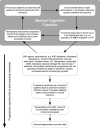Time for a change in the research paradigm for Alzheimer's disease: the value of a chaotic matrix modeling approach
- PMID: 20002628
- PMCID: PMC6493864
- DOI: 10.1111/j.1755-5949.2009.00117.x
Time for a change in the research paradigm for Alzheimer's disease: the value of a chaotic matrix modeling approach
Abstract
The amyloid cascade hypothesis, based on the genetic data from early onset, familial forms of the disease, has been the dominant model for many years and involves over production and deposition of the beta amyloid protein as causal in the disease process. However, it does not apply very well to the more common, later onset, sporadic form of the disease, where a wider range of factors appear to be involved in disease progression. Over recent years, data illustrating reciprocal interactions between the amyloid precursor protein (APP) and its various metabolites with many factors involved in normal synaptic plasticity have emerged. These feedback relationships have the potential to affect the complex kinase cascades involved in every aspect of neuronal function. Further, data regarding the multiple roles of the presenilins have the potential to allow the over expression and deposition of the amyloid beta protein to be both a cause and consequence of disease progression, with relevance in both sporadic and familial of Alzheimer's disease (AD). Disease progression might be better explained by a chaotic matrix of factors and raises the question again whether AD should be approached as a single entity or as a syndrome, with important consequences for disease identification and treatment.
Conflict of interest statement
The authors declare no conflict of interest.
Figures
Similar articles
-
APP transgenic modeling of Alzheimer's disease: mechanisms of neurodegeneration and aberrant neurogenesis.Brain Struct Funct. 2010 Mar;214(2-3):111-26. doi: 10.1007/s00429-009-0232-6. Epub 2009 Nov 29. Brain Struct Funct. 2010. PMID: 20091183 Free PMC article. Review.
-
The role of the amyloid protein precursor (APP) in Alzheimer's disease: does the normal function of APP explain the topography of neurodegeneration?Neurochem Res. 1998 May;23(5):795-806. doi: 10.1023/a:1022471729291. Neurochem Res. 1998. PMID: 9566620 Review.
-
Alzheimer's disease: a dysfunction of the amyloid precursor protein(1).Brain Res. 2000 Dec 15;886(1-2):54-66. doi: 10.1016/s0006-8993(00)02869-9. Brain Res. 2000. PMID: 11119687 Review.
-
On the origin of Alzheimer's disease. Trials and tribulations of the amyloid hypothesis.Ageing Res Rev. 2014 Jan;13:10-2. doi: 10.1016/j.arr.2013.10.001. Epub 2013 Nov 16. Ageing Res Rev. 2014. PMID: 24252390 Review.
-
Cerebrolysin decreases amyloid-beta production by regulating amyloid protein precursor maturation in a transgenic model of Alzheimer's disease.J Neurosci Res. 2006 May 15;83(7):1252-61. doi: 10.1002/jnr.20818. J Neurosci Res. 2006. PMID: 16511867
Cited by
-
Key questions for the future of amyloid research in dementia: a framework for integrating complex datasets.Mol Psychiatry. 2025 Aug 22. doi: 10.1038/s41380-025-03156-0. Online ahead of print. Mol Psychiatry. 2025. PMID: 40847003 Review.
-
The senescence hypothesis of disease progression in Alzheimer disease: an integrated matrix of disease pathways for FAD and SAD.Mol Neurobiol. 2013 Dec;48(3):556-70. doi: 10.1007/s12035-013-8445-3. Epub 2013 Apr 3. Mol Neurobiol. 2013. PMID: 23546742 Review.
-
A Proposal to Make Biomedical Research into Alzheimer's Disease More Democratic Following an International Survey with Researchers.J Alzheimers Dis Rep. 2021 Aug 6;5(1):637-645. doi: 10.3233/ADR-210030. eCollection 2021. J Alzheimers Dis Rep. 2021. PMID: 34632301 Free PMC article.
-
Role of genes linked to sporadic Alzheimer's disease risk in the production of β-amyloid peptides.Proc Natl Acad Sci U S A. 2012 Sep 18;109(38):15307-11. doi: 10.1073/pnas.1201632109. Epub 2012 Sep 4. Proc Natl Acad Sci U S A. 2012. PMID: 22949636 Free PMC article.
-
Understanding the roles of mutations in the amyloid precursor protein in Alzheimer disease.Mol Psychiatry. 2018 Jan;23(1):81-93. doi: 10.1038/mp.2017.218. Epub 2017 Nov 7. Mol Psychiatry. 2018. PMID: 29112196 Review.
References
-
- Blennow K, De Leon MJ, Zetterberg H. Alzheimer's disease. Lancet 2006;368:387–403. - PubMed
-
- Brayne C. Research and Alzheimer's disease: An epidemiological perspective. Psychol Med 1993;23:287–296. - PubMed
-
- Selkoe DJ. Normal and abnormal biology of the beta‐amyloid precursor protein. Annu Rev Neurosci 1994;17:489–517. - PubMed
-
- Hardy JA, Higgins GA. Alzheimer's disease: The amyloid cascade hypothesis. Science 1992;256:184–185. - PubMed
-
- Joseph J, Shukitt‐Hale B, Denisova NA, Martin A, Perry G, Smith MA. Copernicus revisited: Amyloid beta in Alzheimer's disease. Neurobiol Aging 2001;22:131–146. - PubMed
MeSH terms
Substances
Grants and funding
LinkOut - more resources
Full Text Sources
Medical


